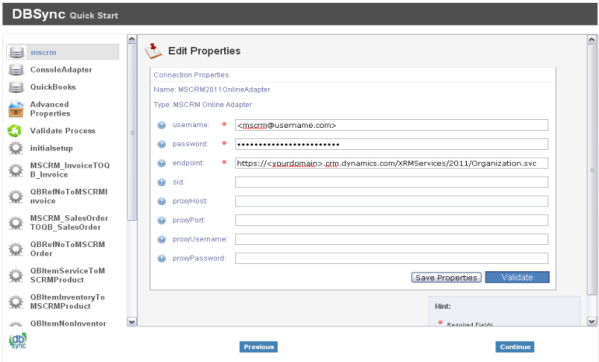2022
Process
Microsoft Dynamics CRM Online to QuickBooks Bidirectional template provides integration between QuickBooks and Microsoft Dynamics CRM Online. The integration solution is defined as a process within the DBSync profile.
Microsoft CRM |
|
QuickBooks |
|---|
Accounts and Contacts as |
|
Customer |
Products as |
|
Items |
Opportunity as |
|
Jobs |
Invoice as |
|
Invoice |
Order as |
|
Sales Order |
Process Map
Microsoft CRM to QuickBooks.
Microsoft CRM |
QuickBooks |
Account/Contact |
Customer |
Opportunity |
Jobs |
Product |
ItemService,ItemInventory,ItemNonInventory |
Invoice |
Invoice |
Order |
Sales Order |
QuickBooks to Microsoft CRM
QuickBooks |
Microsoft CRM |
Customer |
Accounts |
Customer |
Contacts |
Jobs |
Opportunity |
ItemInventory |
Products |
ItemNonInventory |
Products |
Invoice |
Invoice |
Sales Order |
Order |
Microsoft CRM Setup:
- Download the DBSync Microsoft CRM-Quickbooks solution package from the following URL.
https://dbsync01.appmashups.com/appmanager/library/DBMSQB_1_0.zip
- The downloaded MS CRM-Quickbooks solution package will be in a .ZIP format.
- Upload the zipped "DBMSQB_X.zip" solution package to your Microsoft CRM Online instance as shown.
Settings — Customizations — Solutions — Import.
- Browse for the location on your hard drive where "DBMSQB_X.zip" was downloaded and click on Next as shown.
- Once the Solution Package is uploaded to your MS Dynamics CRM Online instance, you should be able to see the same in the Solutions list as shown below. Click on Publish All Customizations button to commit all the changes done to your MS CRM instance.
- After a successful import of the solution package, you will find a section called "DBSync" within Account, Contact, Opportunity, Invoice and Order objects with custom fields that are essential for the Integration process.
Note:
Out of the box DBSync supports Products/Items in a flat structure and not in Hierarchy as Products in Microsoft CRM does not support a Hierarchical structure. Please look at our Knowledge base for steps for handling hierarchies in Items from QuickBooks.
DBSync Setup
- Login into www.mydbsync.com and click on Customer Login.
- Enter your DBSync User Name and Password and click on Login.
- Once logged in, click on "My home" tab from the menu and click on Launch button.
- You will be re-directed to DBSync profile page.
- Click on Quick Start button to navigate to the configuration window as shown.
- Select MSCRM adapter from the top left hand column of the Quickstart window.
- Enter your Microsoft CRM username and password. Make sure you modify the "endpoint" url according to the domain name provided to you by Microsoft at the time of registration for Microsoft Dynamics CRM Online application. A sample example is shown below.
Endpoint : https://*\* (https://**)<Your Microsoft CRM URL>/XRMServices/2011/Organization.svc
- In the above example, your Microsoft CRM URL should be prefixed in place of the default value.
- Scroll down to the bottom of the section and click on Validate button to validate your Microsoft CRM credentials.
Profile Setup
Microsoft CRM
Configuration |
Instructions |
Username |
<<Username>> |
Password |
<<Password>> |
EndPoint |
https:// (https://**)<Your Microsoft CRM URL>*/*XRMServices/2011/Organization.svc |
Transport.compression |
True/False |
sid |
As Applicable |
ProxyHost |
If you use a proxy server then enter the <<proxy ip or host>> |
ProxyPort |
If you use a proxy server then enter the <<proxy port>> |
ProxyUserName |
If you use a proxy server then enter the <<proxy username>> |
ProxyPassword |
If you use a proxy server then ether the <<proxy password>> |
acceptGzip |
As Applicable |
sendGzip |
As Applicable |
Advanced Properties
Configuration |
Instructions |
Log Level |
ALL (It is recommended to set the Log Level as "All") |
PDL : Process Definition Language
Configuration |
Instructions |
Process Name |
Name of the process definition file used for the integration |
Select Process File |
Uploading a process file from an appropriate location on your local drive. |



